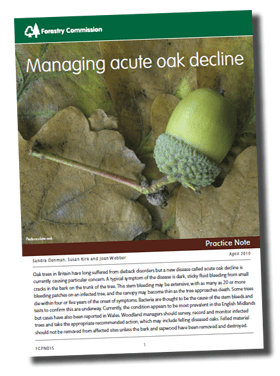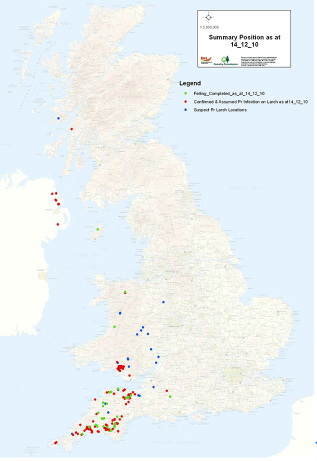Chronic oak decline, acute oak decline, sudden oak death … there is widespread public concern about the health of the nation’s flagship tree species. What’s the difference between these diseases and what causes them?
Chronic oak decline
The deterioration in the condition of an oak tree is often referred to as “oak decline”. It can be caused by a number of abiotic (e.g. drought, wind, soils) or biotic (e.g. pests, diseases, fungus) factors. Chronic oak decline is the slow deterioration of oak trees, usually Pedunculate Oak Quercus robur, visible first in poor foliage condition, followed by death of the finest twigs and ultimately the largest branches over possibly a number of years, or even decades. The tree may die but, in some cases, fully recover. Read more
 Acute oak decline
Acute oak decline
Acute oak decline (AOD) is a relatively new disease in the UK with an increasing number of reported cases each year, mostly in the English Midlands, with records extending into Wales. The main symptom is extensive bleeding on the tree’s stem (trunk). A dark fluid oozes from splits in the bark, often from 1m above ground level and upwards. It is usually found on mature trees, 50 years or older, and both major oak species (Pedunculate and Sessile) in the UK are affected.
Unlike chronic oak decline, a tree affected by AOD may die quickly, within five years. The exact cause(s) of AOD are not known at present but Forest Research believe that a bacteria may be the likely factor.
If you suspect a case, oak trees with symptoms of extensive bleeding may be reported to the Tree Health Diagnostic and Advisory service.
Forest Research is undertaking extensive research into AOD at present. I am helping to raise money to support this important work – read more.
Sudden oak death

Sudden oak death is caused by Phytophthora ramorum which is a fungus-like pathogen. The name Sudden oak death came from the USA where the pathogen has caused the widespread death of Tanoak (Lithocarpus densiflorus) and some native oak (Quercus) species, especially in coastal California and Oregon. In the UK we are fortunate (touch wood!) that our native oaks appear to be more resistant than their American cousins. In the UK an alternative name ramorum dieback may be more appropriate.
In the UK the majority of ramorum dieback cases have been in plant nurseries, on ornamental plants such as Camellia, Rhododendron and Viburnum. There have also been a number of outbreaks in gardens, parks and woodlands, usually associated with infected Rhododendron ponticum.
Until 2009, infection of trees was relatively rare in the UK. However, in August 2009, the disease was found on Japanese larch (Larix kaempferi), killing large numbers of trees in south west England, and later with several cases in Wales, Northern Ireland and the Republic of Ireland (see map), and more recently Scotland. Symptoms on larch include a discolouration of the needles, turning first purple, then black before falling prematurely. Bleeding cankers may be visible on a tree’s stem and branches. Shoots wilt and ultimately the tree’s crown will dieback, followed by tree death.
Gabriel Hemery
There are some excellent sources of information online. I recommend:
Royal Horticultural Society
 This work is licensed under a Creative Commons Attribution- NonCommercial- NoDerivs 3.0 United States License.
This work is licensed under a Creative Commons Attribution- NonCommercial- NoDerivs 3.0 United States License.

I have a mature oak tree in my back garden which we have recently had pruned. and this spring we had an abundant growth of leaves. However in the last month or so the leaves have been shedding and are furled and grey in colour. even the small new shoots at the base of the trunk are the same. Whether they grew like that or just died when the new leaves appeared I don’t know.
Hi Linda – might it be powdery oak mildew? See: https://www.forestry.gov.uk/fr/infd-7b3d24